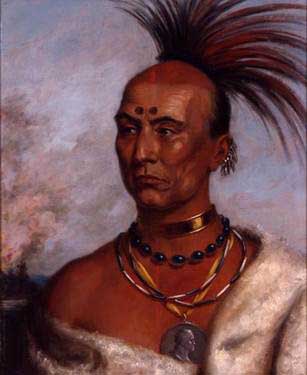
|
With the Chicago Blackhawks winning
the Stanley Cup several years ago, it reminded me of the
team’s namesake. Black Hawk, the great Sauk war chief,
was born in 1767 on the south side of what is now Rock
Island, Illinois. Black Hawk spent considerable time in
Iowa, as most of the Sauk tribal lands were there. He
was a resident of Lee County near the end of his life,
spending the winter of 1837-38 along Devil’s Creek. His
home was no more than 8 miles southeast of West Point or
11 miles east of Donnellson.
Tribal Beginnings
The Sauk (sometimes called Sac), meaning People of the
Yellow Earth, is one of the Algonquian tribes that
originated in the northeastern part of the U.S. and
southeastern Canada. They became closely affiliated
with the Fox (Meskwaki) tribe, which was almost wiped
out through various conflicts. Together, they were
driven further and further westward by white settlers
and military actions during the 18th and 19th centuries.
In the early 1800s, there were Sauk villages at Rock
Island (Saukenauk), Oquawka (Yellow Banks), and Lee
County (Des Moines rapids of the Mississippi River).
The Sauk would typically live in one place during the
warm months to raise corn, squash, and other crops.
They would move to another place for winter hunts and
fur trapping. At the completion of “sugar making” in
early spring, the tribe would move back to summer
quarters.
Sauk skirmishes with other tribes were common and
bloody. Black Hawk killed his first man by the time he
was 15. He led war parties to victory before his 18th
birthday. The first time he fought directly with U.S.
forces, however, was at Fort Madison. During the War of
1812, he fought on the side of the British,
participating in actions as far away as the banks of
Lake Erie.
The Construction of
Fort Madison
The Sauk chiefs were called to St. Louis by the U.S.
government in 1804. The purpose of their visit was to
obtain the release of a Sauk man who was imprisoned
there. Upon their arrival, the chiefs were told the
prisoner would only be released if they signed a cession
for 50 million acres of land east of the Mississippi.
The treaty also allowed the government to build a
“factory” (trading post) in Sauk territory west of the
Mississippi. The government hoped this new facility
would weaken the Sauks’ reliance on the British for
their merchandise. Black Hawk claimed later that the
government did not fully disclose the terms of the
treaty to the Sauks, who could not read. In any case,
the treaty caused bitter, ongoing relations between the
parties.
Four years after the treaty was signed, white men came
up the Mississippi from St. Louis to build the trading
post and a fort to guard it. Black Hawk was
uncomfortable with their presence from the beginning.
As he himself recalled it, “…a war chief, with a party
of soldiers, came up in keel boats, and encamped a short
distance above the head of the Des Moines rapids (in
other words, upriver from Montrose) of the Mississippi
River, and commenced cutting timber and building
houses. The news of their arrival was soon carried to
all the (Sauk) villages, when council after council was
held. We could not understand the intention, or reason,
why the Americans wanted to build houses at that place.
But (we) were told that they were a party of soldiers,
who had brought great guns with them—and looked like a
war party of whites!”
“A number of our people immediately went down to see
what was doing—myself among them. On our arrival, we
found they were building a fort! The soldiers were
busily engaged in cutting timber; and I observed that
they took their arms with them, when they went to the
woods. And the whole party acted as they would do in an
enemy’s country!” The officers at the new fort told the
chiefs they were building houses for a trader, who was
coming there to live, and would sell the Sauk reasonably
priced goods. That did not impress the Sauks, as they
had previously found American goods to be inferior to
those they bought from the British.
Uprising at Fort
Madison
Fort Madison became the first U.S. military post in the
upper Mississippi. The garrison originally numbered
about 60 men of the First U.S. Infantry Regiment, and
trading post employees lived outside the fort. In the
spring of 1809, when the fort walls were still
incomplete and only about five feet high, Black Hawk’s
band made an unsuccessful attempt to rush the main
gate. Black Hawk also participated in at least one
assault on the fort in 1811.
During the War of 1812, Black Hawk again attacked Fort
Madison. Sauk braves and about 200 Winnebagoes
stealthily marched to the vicinity, arriving during the
night (probably September 5). According to Black Hawk,
“The spies that we had sent out several days before to
watch the movements of those at the garrison, and
ascertain their numbers, came to us and gave the
following information: A keel arrived from (downriver)
this evening with seventeen men. There are about 50 men
in the fort and they march out every morning to
exercise. It was immediately determined that we should
conceal ourselves in a position as near as practicable
to where the soldiers should come out, and when the
signal was given each one was to fire on them and rush
into the fort.”
“With my knife, I dug a hole in the ground deep enough
that by placing a few weeds around it, succeeded in
concealing myself. I was so near the fort that I could
hear the sentinels walking on their beats. By day break
I had finished my work and was anxiously awaiting the
rising of the sun. The morning drum beat. I examined
the priming of my gun, and eagerly watched for the gate
to open. It did open, but instead of the troops, a
young man came out alone and the gate closed after him.
He passed so close to me that I could have killed him
with my knife, but I let him pass unharmed.”
“The gate opened again when four men emerged and went
down to the river for wood. While they were gone,
another man came out, walked toward the river, was fired
on and killed by a Winnebago. The others started and
ran rapidly toward the fort, but two of them were shot
down dead. We then took shelter under the river’s bank
out of reach of the firing from the fort. The firing
now commenced from both parties and was kept up without
cessation all day. I advised our party to set fire to
the fort, and commenced preparing arrows for that
purpose.”
The Indians kept the fort under siege from September
6-8. However, the efforts failed. Their attempts to
set fire to the fort were unsuccessful due to the
soldiers’ use of gun barrels as water-filled syringes.
Finding they could not take the fort, the Indians
returned home, having one Winnebago killed and one
wounded during the siege. However, after repeated tries
the Winnebagoes, without the assistance of Black Hawk,
were finally able to drive the soldiers from the fort in
July 1813.
The Black Hawk War
The most significant and documented time of Black Hawk’s
life was his involvement in a war in 1832 that came to
be named for him. The war was yet another outcome of
the dispute over the 1804 treaty that required the Sauk
and Fox tribes to vacate their lands in Illinois. Black
Hawk and others claimed the treaty was invalid because
it had not been approved by the full tribal councils.
He could not stand the thought of leaving his beloved
Saukenuk village on the Rock River. His band of 500
warriors and 1,000 old men, women, and children chose to
fight for the land they believed was theirs.
Starting with a war dance on the Mississippi shore in
Keokuk, witnessed by some of the early settlers there,
they headed north. However, their fight against the
white militias did not end well. After being chased
through much of northern Illinois and southern
Wisconsin, the Sauks suffered a decisive defeat near the
mouth of the Bad Axe River. That is across the
Mississippi River from what is now New Albin, Iowa.
He and the other defeated chiefs were stood before
President Andrew Jackson on April 25, 1833. He was
described as a hollow-cheeked, hook-nosed Sauk whose
scalp was plucked bald except for a short tuft of hair
on top. After temporary imprisonment at Fortress Monroe
in Virginia, he and some of the other chiefs were
paraded through many of the large, eastern cities where
they drew huge crowds. They were later allowed to
return to the Sauk lands, where they encamped along the
Iowa River.
On Devil’s Creek
Eventually, Black Hawk was no longer allowed to live
with members of his own tribe along the Iowa River, as
he was seen as stirring up dissension. At around age
70, he moved to Lee County, spending considerable time
along the Skunk River, an area he called his favorite
hunting ground. He passed the winter of 1837-38 along
Devil’s Creek. The creek starts between West Point and
Fort Madison, and flows southward into Sugar Creek. The
confluence is just southwest of the current intersection
of Highways 2 and 61. During Black Hawk’s time on
Devil’s Creek, white settlements extended only 40 west
of the Mississippi.
At that time, Black Hawk was described as rather small
in stature, and very slight, not weighing much over 125
pounds. He was bald and shriveled. At home, he would
dress in the style of the other chiefs and draped a
blanket over his shoulders. When in public, he
customarily wore a fine broadcloth suit, a high silk
hat, and moccasins. He often carried a pipe (and a fan
in summer).
He always had but one wife, Asshewequa (Singing Bird),
over the course of 40 years. His two sons were Nasomsee
and Nasheakusk. The older son was seen as a one of the
most promising braves of the tribe. The boys passed
their time mainly by hunting deer, wild turkeys, and
prairie hens. His daughter, Nauasia, was said to be a
great beauty and a popular dance partner at social
occasions in Fort Madison.
Black Hawk’s home was described as a large wickiup
(brush shelter), but must have been more substantial as
it contained some furniture and mattresses. He spent
considerable time learning to use mechanical tools and
improving their dwelling. One room was devoted to his
relics and possessions. He had at least 12 large
leather trunks with mementoes he brought back from the
east. Among his valued possessions were medals from
Presidents Jackson and Madison, and the British
government.
Black Hawk welcomed visitors to his home, and his wife
routinely handed out gifts of maple sugar. He also
visited some of the white settlers in their homes and
was known to appreciate a good meal, a healthy slice of
mince pie, and coffee.
William Carroll Reed, one of the earliest settlers in
the Fort Madison area, lived no more than a mile away.
He first met Black Hawk in the fall of 1837. One of
Reed’s first impressions was that Black Hawk’s
disposition was fairly meek and mild for one who had
been a fierce warrior and taken scalps in his youth.
His spirit seemed to have been broken.
The second time Reed saw him, Black Hawk left his home
to go to Fort Madison for whiskey. Later in the day, he
returned home. Reed could see that he had been
drinking, but was still “walking tall.” Black Hawk,
Reed observed, “could drink an awful lot of whiskey and
never show any effects of it.” Reed said he did not
regard him as a drunkard. Most importantly, Reed came
to see him as a good family man and a good neighbor.
Hawkins Taylor, then a resident of West Point and later
a member of Iowa’s first territorial legislature, was a
periodic visitor in Black Hawk’s lodge. Taylor
expressed high regard for Black Hawk and his family.
A Sighting in West
Point
There were probably several times that Black Hawk
visited West Point, as it was one of the closest
settlements to his home. On one of those occasions,
William Patterson, one of the town’s founders, saw Black
Hawk ride toward the center of town. He had the same
formal dress and soldierly posture described by others.
Some ladies sent for him to come to the parlor of a
hotel on the square where they had gathered. [Writer’s
note: This may have been the inn that Patterson himself
started and operated.] Black Hawk went to see them as
requested.
An individual by the name of John Stout, described as an
“ignorant, rough old countryman,” was already in the
room. It was believed that Stout knew only enough of
the Sauk language to get himself in trouble. For some
reason, he yelled to Black Hawk “Puck-a-chee!” Maybe he
thought it was a greeting. Maybe he just wanted to say
something in Black Hawk’s tongue. Unfortunately, that
word translates as “leave here” or “go away.”
Black Hawk rose indignantly, his eyes flashing fire. He
walked out majestically, mounted his horse, and left
town at once.
At about the same time, he was introduced in another
nearby town to several women, one with very fine hair
who gave him a tomahawk. Black Hawk patted her on the
head, looked over to his son, and said, “What a
beautiful head for scalping!”
His Final Year
In the spring of 1838, the family built a new home along
the Des Moines River in Davis County. But Black Hawk
was called back to Ft. Madison to deliver an address on
July 4, the date on which Iowa became a territory. “It
has pleased the Great Spirit that I am here today,” he
said. “I have eaten with my white friends…A few winters
ago I was fighting against you. I did wrong, perhaps;
but that is past, it is buried, let it be forgotten…I
was once a great warrior. I am now poor…I have looked
upon the Mississippi since I have been a child. I love
the Great River. I look upon it now.” On October 3 of
that year, after a seven-day illness, he died at his
home in Davis County.
Black Hawk’s Legacy
The Sauk war chief is the namesake for various colleges
and lower-level schools, counties and other governments,
and the oldest newspaper in Iowa. The term “Hawkeye
State” was suggested in his honor by James Edwards, then
editor of the Fort Madison Patriot and later editor of
the Burlington Hawk Eye. There are also, of course, the
military helicopter and the combat film Blackhawk Down.
First and foremost, Black Hawk was a successful leader
of men. He was not a physically imposing man, and was
not technically even a tribal chief. However, men
eagerly followed him on the warpath. Ultimately,
though, he was overwhelmed by the sheer number of white
settlers and militias who pushed his tribe from the
Mississippi valley.
Sports trivia: I believe Black Hawk is the only
individual for whom a major professional sports team is
named. Actually, there are two teams. I already
mentioned the Chicago Blackhawks of the NHL. The other
team may be a challenge even for avid sports fans. It
is the Atlantic Hawks of the NBA. The Hawks’ franchise
descended from the Tri-Cities Blackhawks, started in
1946 in Moline, Illinois. Red Auerbach was their
coach. The team later moved to Milwaukee, where the
team name was shortened to Hawks, and then to St. Louis
and Atlanta.
--John Stuekerjuergen
|
|



